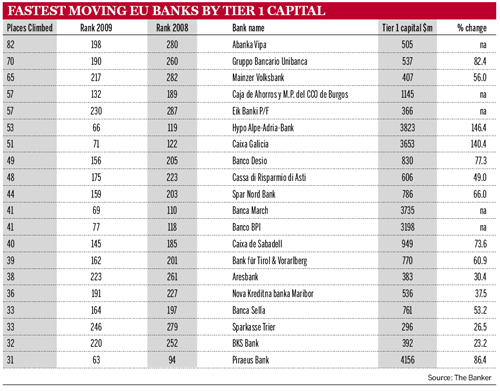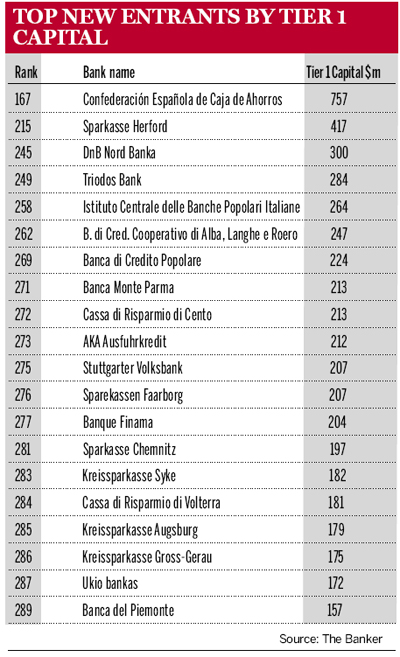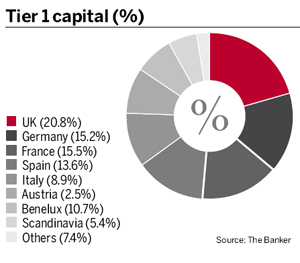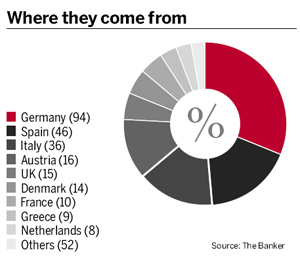Although the top 10 EU banks retained their solid grip on the 2008 ranking, profits were significantly down across the board and capital structures were seriously damaged compared with banks in other parts of the world. Writer Stephen Timewell
The landscape of the Top 300 EU banks has changed dramatically over the past 18 months as the global financial crisis has led to a destruction of profits, a restructuring of many institutions, huge government intervention and a reassessment of the fundamental regulatory apparatus. This 2009 listing, which includes only end-2008 results, reflects just part of the crisis's overall impact as developments this year, such as the Lloyds takeover of Halifax Bank of Scotland (HBOS) officially approved in January, and the dismantling of Fortis, will only be seen in next year's listing.
An initial glance at the latest Top 300 suggests that little has changed, but further analysis reveals the devastation that has been wrought. The top 10 banks in the list remains remarkably unchanged. The UK government recapitalised Royal Bank of Scotland, which swapped places with HSBC to head the table with a Tier 1 capital of $101.8bn, a 14.6% increase. While HSBC's capital slipped 9.2% to $95.3bn, Banco Santander's capital increased 11.6% to $65.3bn, and HBOS slipped to 17th place, the leading group looked much the same, with the aggregate Tier 1 capital of the top 10 rising just 1.7% to reach $624.2bn at the end of 2008.
Despite RBS's huge $59.3bn loss in 2008, the top 10 still maintained their solid grip on the Top 300, with their aggregate Tier 1 capital of $624.2bn accounting for 38.8% of the Top 300 aggregate capital of $1606.9bn, up from 37.1% the previous year.
Gloomy picture
Examining the listings as a whole, the Top 300 EU banks did not finish 2008 in a good position. In a year where the aggregate capital of the Top 1000 World Banks grew by 9.7% to $4276bn, due to some huge government bailouts in the US and growth in emerging markets, the EU 300 finished the year in decline. The aggregate Top 300 Tier 1 capital fell by 2.8% to $1606.9bn (including revisions) with a record 75 banks in the EU reporting declines in Tier 1 capital compared with 30 banks the previous year.
In comparative terms, the Top 300 banks' capital structures were severely damaged in relation to banks globally. Comparing the Top 300 EU Banks listings with the Top 1000 World Banks listings, last year's 2008 listing showed that the Top 300 EU banks accounted for 42.4% of the Top 1000 in Tier 1 capital terms. This year's listing shows that the EU banks have fallen significantly to 37.6% of the Top 1000 total. Whether the EU banks will regain their global status in next year's listing depends on whether they can avoid the writedowns and losses of 2008 and whether confidence in EU banking can be restored.
The net pre-tax profits picture of the Top 300 represents a particularly grim scene. A record 48 banks in the Top 300 made losses in 2008 and the impact of the aggregate losses, including those of RBS and other big banks, has had a devastating effect on the EU banks' aggregate pre-tax profits. While the 2008 listing (based on 2007 results) showed aggregate profits of $324.3bn, amounting to 41.5% of the 2008 Top 1000 World Banks listing, the aggregate profits of the 2009 Top 300 (including some revised figures) were decimated, reaching a mere $7.3bn, just 2.3% of the previous year's total. The EU banks' profits were just 6.3% of the Top 1000 total, a record poor performance.
Main casualties
Who were biggest sufferers? The UK banks (with figures revised from the Top 1000) suffered aggregate losses of $48.6bn, led by RBS and HBOS with losses of $59bn and $15.8bn, respectively. In terms of Tier 1 capital, the UK banks' total fell by nearly $40bn to $334.6bn, accounting for a reduced 20.8% of the 2009 Top 300 listing, down from 22.5% the previous year.
France's 10 banks took hits on profits, but largely maintained their aggregate capital level at $248.6bn, which amounted to 15.5% of the Top 300 total. Germany's 94 banks, five more than last year, suffered losses, but their aggregate capital decreased by just $10bn at the end of 2008 to reach $243.9bn, 15.2% of the Top 300 total and marginally less than the previous year's 15.3% figure.
Meanwhile, the 46 Spanish banks, which were restricted in their risk taking, avoided some of the heavy losses of others and managed to increase their aggregate Tier 1 capital by nearly $10bn to $219.1bn, 13.6% of the EU total and an increase from 12.7% the previous year.
The UK's HBOS dropped sharply in the listing to 17th place from seventh last year, but will disappear from next year's listing following its 2009 merger with Lloyds TSB Group. France's Société Générale jumped from 16th place to 11th following a 32.6% capital increase and Germany's Commerzbank leaped from 20th position to 14th after a 30.2% increase.
Some of the big declines included the UK's Lloyds TSB Group, with capital down 28.6%, slipping from 18th place to 22nd, and France's Groupe Caisse d'Epargne, down 54.9% and falling from 15th position to 29th. Irish banks have suffered as a result of the crisis and the government has stepped in, leaving the capital position of the three major banks in a mixed position at end 2008: Bank of Ireland was up 18.1%, Allied Irish Banks down 10.7% and Anglo Irish Bank Corporation down 32%. But in September 2009, the Irish government announced a 'bad bank' plan to absorb €77bn of bad property loans. Like many countries, various such schemes emerging now will continue to change the shape of banking structures across the EU.
A number of other banks have dramatically moved up the Top 300 rankings. In The Banker's fastest movers listing, 20 banks have risen more than 30 places, led by Slovenia's Abanka Vipa, which leaped 82 places to 198th position in the listing. The second fastest mover was Italy's Gruppo Bancario Unibanca, which rose 70 places to 190th position, followed by Germany's Mainzer Volksbank, up 65 places to 217th position.
Overall, there were 20 new entrants into the Top 300, with the highest entrant being Spain's Confederación Española de Cajas de Ahorros coming in at 167th position, followed by Germany's Sparkasse Herford at 215th place and Latvia's DnB Nord Banka, in at 245th place.






